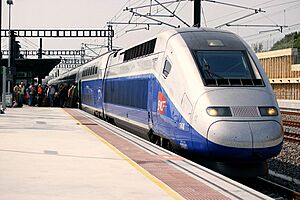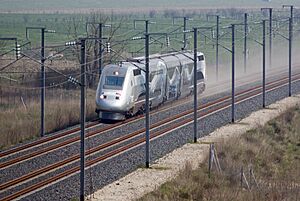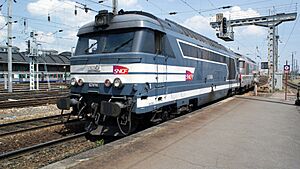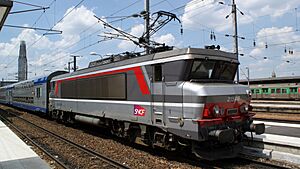SNCF facts for kids
 |
|
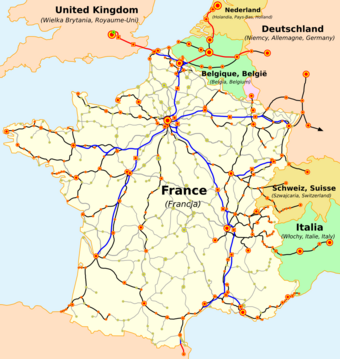
Map of the French railways on which the TGV (high speed tracks: blue; normal tracks: black) and Intercités (grey) SNCF trains run
|
|
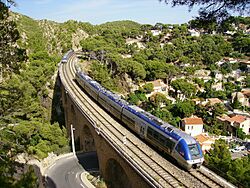
TER PACA service west of Marseille
|
|
| Overview | |
|---|---|
| Headquarters | Saint-Denis, France |
| Reporting mark | TGV, Intercités, TER, Transilien, Ouigo, Eurostar, TGV Lyria |
| Locale | France |
| Dates of operation | 1938–present |
| Predecessor | Compagnie des chemins de fer du Nord Administration des chemins de fer d'Alsace et de Lorraine Compagnie des chemins de fer de Paris à Lyon et à la Méditerranée Compagnie du chemin de fer de Paris à Orléans Compagnie des chemins de fer du Midi et du Canal latéral à la Garonne Compagnie des chemins de fer de l'Est Administration des chemins de fer de l'État |
| Technical | |
| Track gauge | 1,435 mm (4 ft 8 1⁄2 in) and 1,000 mm (3 ft 3 3⁄8 in) |
| Length | 29,273 km (18,189 mi) |
| Other | |
| Website | www.groupe-sncf.com |
| State-owned société anonyme EPIC between 1983 and 2019 |
|
| Industry | Rail transport |
| Founded | 1 January 1938 |
| Founder | Government of France |
| Headquarters |
,
France
|
|
Key people
|
Jean-Pierre Farandou (president of SNCF Group) |
| Revenue | |
|
Operating income
|
|
| Total assets | |
| Total equity | |
| Owner | French state |
|
Number of employees
|
270,296 (2021) |
| Subsidiaries |
|
The Société nationale des chemins de fer français (which means "National Company of the French Railways"), or SNCF, is France's main railway company. It is owned by the French government. SNCF started on January 1, 1938. It runs almost all train services in France and Monaco. This includes the super-fast TGV trains.
SNCF does many things. It operates trains for people and for moving goods. It also manages the railway tracks and stations. The railway network in France is huge, about 35,000 km (22,000 mi) long. About 2,600 km (1,600 mi) of these are special high-speed lines. Every day, around 14,000 trains run on the SNCF network. The SNCF Group has over 275,000 employees around the world. Its main office is in Saint-Denis, near Paris.
Contents
What SNCF Does
High-Speed Trains: The TGV
SNCF is famous for its TGV trains. TGV stands for Train à Grande Vitesse, which means "high-speed train." In the 1970s, SNCF wanted to build the fastest railway network in the world. The first TGV line opened in 1981. It connected Paris to Lyon.
Today, the SNCF network has 28,710 km (17,840 mi) of lines. About 2,640 km are high-speed lines. SNCF runs 15,000 trains daily. It carries over 5 million passengers and 250,000 tonnes of goods. TGV technology is now used in many other European countries.
The TGV has set many world speed records. On April 3, 2007, a special TGV called the V150 broke the record for conventional trains. It reached an amazing speed of 574.8 km/h (357.2 mph). This train had bigger wheels and a more powerful engine.
SNCF's TGV system has a very good safety record. After almost 30 years of operation, there has been only one serious accident. This happened during a test, not during a regular passenger trip.
SNCF's Global Reach
SNCF works with railway systems in many countries. They share their knowledge and help with different projects. This includes freight lines, inter-city lines, and commuter lines. SNCF experts help with planning, building, running, and maintaining railways.
Here are some examples of where SNCF has helped:
- Israel: SNCF helped Israel Railways improve safety and operations.
- Taiwan: SNCF trained train controllers, drivers, and crew for Taiwan's high-speed rail.
- United Kingdom: SNCF checked how high-speed lines were maintained. They gave ideas for improvements.
- South Korea: SNCF advised on electrifying tracks and connecting them to high-speed lines. They also trained many railway staff.
- Spain: SNCF helped install and maintain the railway signaling system on a high-speed line.
- Morocco: SNCF helped design, build, and operate the Al Boraq high-speed train service. This train runs between Tangier and Casablanca.
In France, SNCF maintains a huge amount of railway equipment. This includes 32,000 km (20,000 mi) of tracks and thousands of locomotives. Each TGV train travels over 39,000 km (24,000 mi) every month. That's like going around the world!
History of SNCF
SNCF was created in 1938. This happened when the French government took over several private railway companies. The government wanted to bring all these companies together. At first, the French government owned 51% of SNCF. Now, the French state owns 100% of the company.
SNCF During World War II
During World War II, from 1940 to 1944, SNCF was used by the German forces. They used the trains to move soldiers and supplies. Many French railway bridges and tunnels were destroyed during this time.
French railway workers played a brave role in the French Resistance. They tried to stop the German forces by damaging railway lines. Many SNCF employees were killed or sent away for their acts of resistance. Around 1,700 railway workers lost their lives or were deported.
SNCF was also forced by the German and Vichy authorities to transport people, including Jewish individuals, to the border. This was a very sad part of history. SNCF did not make money from these transports. In 2014, SNCF agreed to pay compensation to Holocaust survivors in the United States.
Modern Changes
In the early 2000s, SNCF looked at helping with a high-speed train project in California. However, they later decided not to be part of it. Instead, they went to Morocco to help build their bullet train service. Morocco's train started running in 2018.
In 2014, SNCF found a problem with 2,000 new trains they ordered. The trains were too wide for many of France's regional platforms. Work began to fix the platforms.
On January 1, 2015, some parts of SNCF were reorganized. The company that managed the railway network, Réseau ferré de France, became part of SNCF Réseau. Other parts became SNCF Mobilités. All these groups are now under the main SNCF company.
In July 2024, just before the 2024 Summer Olympics in Paris, SNCF's high-speed rail network, including Eurostar, faced problems. There were reports of coordinated damage to railway lines. This caused big delays for many trains, affecting hundreds of thousands of travelers.
Train Design
A famous designer named Paul Arzens created the look of many SNCF locomotives. He worked from the 1940s to the 1970s. One of his well-known designs is the "broken nose" style for electric and diesel trains.
Working with Airlines
SNCF works with many airlines. This means you can book a train trip from Charles de Gaulle Airport near Paris to many French cities at the same time you book your flight. Airlines like Air France, Emirates, and Qatar Airways are part of this program.
How SNCF is Organized
Main Offices
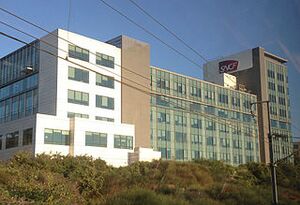
SNCF's main office has moved a few times. For a long time, it was in Paris. From 1999 to 2013, it was in the Montparnasse area. Since July 2013, the main office has been in Saint-Denis, a suburb of Paris. This move helped the company save money.
Main Parts of SNCF
Since January 1, 2020, SNCF is a group of companies. It has a main company (SNCF) and several smaller companies that work on their own.
- SNCF Réseau: This part manages the railway tracks and signals. It makes sure trains can run safely.
- SNCF Gares & Connexions: This group takes care of the 3,000 train stations in France. They keep them in good shape.
- SNCF Voyageurs: This company runs the passenger trains in France and Europe. This includes:
- The main TGV inOui high-speed service.
- The cheaper Ouigo TGV service.
- Long-distance Intercités trains.
- Regional trains called TER and Transilien.
- Rail Logistics Europe: This part handles freight (goods) transport by train.
- Geodis: This company helps with moving goods and logistics. SNCF owns most of it.
- Keolis: This company runs public transport in cities around the world. This includes buses, metros, and light rail. SNCF owns 70% of Keolis.
Other Companies SNCF Owns
SNCF also owns parts of many other companies. Most of these are related to trains or transport. For example:
- Eurostar International: SNCF owns 55% of Eurostar, which runs trains through the Channel Tunnel to the UK.
- Lyria: This company runs high-speed trains between France and Switzerland. SNCF owns 74% of it.
- Ouigo España: This company runs low-cost high-speed trains in Spain.
- SNCF Connect: This is SNCF's online travel agency for booking tickets.
- AREP: This company designs train stations and other railway buildings.
- SYSTRA: This company provides engineering services for public transport projects.
SNCF's Public Image
Surveys show that many French people have a good opinion of SNCF. In 2019, about 50% of people had a good image of the company. In 2020, SNCF was ranked among the "most admired French companies."
Safety on trains is very important to SNCF. About 2,800 railway workers are part of the Railway Security team. They help keep everyone safe. Experts also compare railway systems in different European countries. France's railway system is ranked among the top countries for its use, quality, and safety.
SNCF's Look and Sound
Logo
SNCF's current logo was designed in 2005. It was updated slightly in 2011. The logo has rounded corners and clear letters.
Sound
SNCF has a special sound logo. It's a short tune with four notes. This tune was created in 2005. The famous guitarist David Gilmour from the band Pink Floyd even used it as inspiration for one of his songs. The voice you hear making announcements on SNCF trains has been Simone Hérault since 1981.
SNCF in Movies and TV
SNCF's trains and stations are often seen in movies. It is the company that hosts the most film shoots in France. Around 50 to 60 films are shot there each year.
Some famous movies where SNCF is featured include:
- Hugo
- Mr. Bean's Holiday
- Mission: Impossible
- The Tourist
It has also appeared in TV shows like Killing Eve.
|
See also
 In Spanish: SNCF para niños
In Spanish: SNCF para niños


